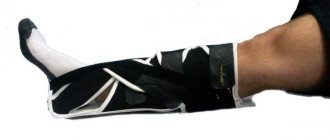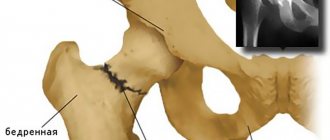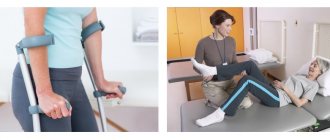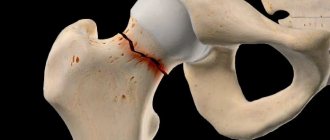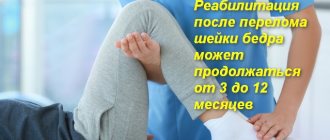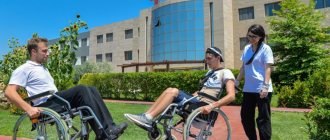Older people are highly susceptible to injury, especially hip fracture, which is accompanied by pain in the hip joint and impaired weight-bearing function of the affected leg. There are horror stories about this injury, which, unfortunately, have a basis in reality. Indeed, often after a hip fracture, older people become disabled. Therefore, it is extremely important to understand how to recognize an injury, what should be done in such situations, and how to rationally assess the chances of full recovery.
Causes and prerequisites for injury
The femoral neck is one of the components of the femur, considered the largest bone in the human body. The neck is a bridge of less thickness than the rest of the elements of the femur, connecting its head and body. In turn, the ball-shaped head of the femur fits tightly into the acetabulum, thus forming the hip joint.
A hip fracture, even in young people, is considered a serious injury that requires long-term treatment, often surgical, and quite complex rehabilitation. For older people, it is even more serious, since due to age-related changes and existing chronic diseases, bones have a significantly lower ability to regenerate. Therefore, they may not heal properly, which will deprive the elderly person of the ability to move independently. At the same time, a long period of immobility, required to create favorable conditions for the consolidation of bone fragments, is fraught for older people with the development of severe complications, including:
- congestive pneumonia;
- thrombosis;
- arthritis and arthrosis;
- atrophy of the femoral head;
- bedsores;
- constipation;
- mental disorders.
The main cause of hip fracture in older people is a fall. Somewhat less often, road accidents lead to it. Although even a minor blow or careless movement, placing the leg in the wrong position can cause a fracture of the femoral neck.
Predisposes its occurrence under the influence of traumatic factors by the presence of osteoporosis, i.e., a decrease in bone density as a result of age-related calcium loss. However, not all older people are equally susceptible to hip fractures. The greatest risk is inherent in those whose femoral neck, due to genetic changes, has the following features:
- absence of periosteum, i.e. the shell of the bone, which takes part in providing its nutrition;
- located at right angles to the thigh;
- has only 1 or 2 blood vessels, which, as age-related changes occur, cease to cope with their tasks.
They also create favorable conditions for a femoral neck fracture:
- chronic diseases of the musculoskeletal system;
- serious changes in hormonal levels;
- prolonged forced or voluntary fasting, including adherence to strict diets;
- deficiency of vitamin D and calcium, which can be caused by both dietary errors and insufficient exposure to fresh air;
- metabolic disorders as a result of the development of pathologies of the gastrointestinal tract, endocrine and other systems, including diabetes mellitus, cirrhosis of the liver, and kidney pathologies;
- overweight, especially advanced cases of obesity;
- sedentary lifestyle;
- bad habits that persist for years and negatively affect the functioning of all internal organs and the condition of bone tissue.
Women who are entering menopause and after it often break their femoral neck, since at this time there is a sharp change in hormonal levels.
Types of femoral neck fractures
Depending on which part of the femoral neck the injury occurred, the following fractures are distinguished:
- subcapital - the fracture is located directly under the head of the femur;
- transcervical – the fracture is located in the central part of the neck;
- basal - the fracture line runs at the base of the femoral body.
Also, femoral neck fractures are divided into types based on the resulting changes. This:
- impacted fractures, accompanied by the penetration of one bone fragment into another;
- adduction (varus), in which the head of the femur moves down and inward;
- abduction (valgus), which occurs when the leg is moved to the side and is accompanied by a displacement of the head up and out.
When bone fragments are displaced, patients suffer from severe pain and the formation of large hematomas. In such situations, it is necessary to obtain qualified medical assistance as soon as possible.
How to properly apply a bandage to your legs for a femoral neck fracture?
1. Use an elastic bandage “Intex” of low elongation (up to 50% of the length), 5 m long and 10-12 cm wide. 2. Apply an elastic bandage to both legs. Since the patient does not move, a blood clot can form in the vessels of the uninjured leg. 3. Bandage your feet in the morning when swelling is minimal. 4. Bandage your feet from the base of your toes to the groin folds. Make sure that each new round of bandage overlaps the previous one by 1/3. 5. Stretch the bandage around your feet and ankles. As you bandage your shins and knees, gradually release the tension until it becomes minimal at mid-thigh. 6. Secure the bandage in the area of the groin folds using the clip that is included in the set with the Intex bandage.
Symptoms
In older people, fractures are not always accompanied by acute pain and swelling. And even such a severe injury as damage to the femoral neck, in certain cases can occur as an exacerbation of arthrosis or other pathology of the hip joint, which is aggravated by the absence of visible reasons to suspect an injury. However, this delays the diagnosis and worsens the prognosis. Therefore, you should contact an orthopedist-traumatologist if the following symptoms appear:
- Pain in the hip or groin area, which may occur at rest and intensify during physical activity, especially when resting on the heel. In some situations, when, as a result of a fracture, the nerve passing through the hip joint suffers due to irritation by bone fragments or compression by swollen soft tissues, the pain may radiate to the heel.
- Impairment of the supporting function of the affected leg, up to the loss of the ability to move independently without support or support.
- Turning the injured leg outward while calmly remaining in a horizontal position. In this case, the patient cannot turn it to its normal position.
- Shortening of the leg is typical for displaced or impacted fractures. But this is usually accompanied by acute pain, which can only be reduced with strong painkillers.
- Formation of a hematoma in the thigh or groin area, which results from damage to blood vessels and muscles during a fall or as a result of injury from displaced bone fragments. But in obese elderly people, the hematoma may not appear externally due to the large volume of subcutaneous fat.
In the absence of timely, adequate treatment, the likelihood of developing aseptic necrosis of the femoral head, i.e., its death and gradual resorption, increases sharply.
First aid for a hip fracture
If you suspect a femoral neck fracture in an elderly person, you must first:
- Carefully move the victim to a safe place if the injury occurred during a traffic accident. If you fall at home or on the street, but outside the roadway, you should not try to transport the victim even over short distances.
- Avoid any stress on the injured limb or involving the entire lower half of the body, as they can aggravate the situation. To do this, it is important to convince the victim to remain lying down and remain motionless, and also to completely abandon attempts to get to his feet until the emergency medical team arrives.
- Avoid any attempts to straighten the limb yourself if there is an open wound. But it must be treated with a disinfectant solution and covered with a sterile bandage. If only a hematoma or swelling has formed, apply an ice pack to it.
- If possible, before the arrival of the medical team, it is worth immobilizing the injured limb using 2 boards of different lengths, applied on both sides of the injured leg. One of them is fixed in the groin and heel area, and the second at the armpit and heel. Both boards are firmly secured with bandages or scraps of fabric, a scarf, etc.
- In case of very severe pain, you can give the victim a painkiller tablet from the NSAID group of drugs (Nurofen, Panadol, Ibuprofen, Nise).
Femoral neck fracture. Treatment and rehabilitation
Unfortunately, it is not so much the fracture itself that is dangerous, but its complications. Therefore, after an injury, every effort must be made to save the patient’s life. In addition to the derotational boot, the following medical products are required to be purchased:
- Anti-embolic jersey. Improves venous outflow in the shin area and prevents the formation of blood clots. The peculiarity of the fabric allows you to wear it for up to 7 days without taking it off. Medical knitwear is distinguished by graduated compression - it presses on different parts of the leg with different, scientifically calculated forces.
- Anti-decubitus mattress. An infected bedsore is a serious condition. In older people, this pathology can occur already on the second or third day of bed rest. Mattresses with air compressors protect the skin and muscles and greatly reduce the risk of complications.
- Nice walkers. The primary goal of treatment is to mobilize the patient as early as possible. Support means must be reliable, high quality and comfortable.
Medtechnika Orthosalon always has comfortable, effective and lightweight derotational boots in stock. Their difference is minimal weight, maximum strength, removable breathable lining. Consultants at the salon or online store will help you choose the size of the product and advise on related products.
Diagnostics
Initially, the doctor conducts a survey of the patient and his relatives, finding out the nature of the complaints and the circumstances of their occurrence. After this, he begins an examination, during which he evaluates the severity of the pain syndrome, the position of the leg when the patient is in a supine position, the motor ability of the affected limb, the presence of soft tissue swelling and hematomas. Sometimes, to get a clearer picture of the situation, the doctor may ask the patient, who remains in a supine position, to try to raise his heel. When a femoral neck is fractured, this simple manipulation often fails.
Based on the totality of the detected signs, the orthopedist-traumatologist can already assume the presence of a fracture. But to confirm it, as well as establish the type, which is important for developing optimal treatment tactics and creating the most favorable conditions for recovery, an x-ray of the hip joint is required.
If the obtained images turn out to be uninformative, the patient is recommended to undergo a CT scan or computed tomography scan of the hip joint of the injured leg. Today, this method of diagnosing bone pathologies is the most accurate and informative. It allows you to detect the slightest deviations from the norm and assess the complexity of a femoral neck fracture as objectively as possible.
Hip orthosis
A hip orthosis is a special orthopedic device that allows you to rigidly fix the damaged joint in the desired position for the entire period of post-traumatic rehabilitation. At the same time, it relieves the load from the limb, reduces pain, and shortens the period of recovery and treatment. Elastic clamps compress the hip, stabilize the limb, and help protect it from injury. Adjustable models of hip bandages allow you to fix and hold it in the optimal position.
Orthoses are divided into hard (necessary for conservative treatment and immediately after surgery) and soft (a supporting bandage for a fragile joint, applied after the fracture heals).
Rigid hip orthoses are:
- fixing - provide reliable fixation of the joint and protect against displacement;
- abductors - fix the desired angle of leg abduction, which is required in the initial stages of rehabilitation.
Advantages of a hip orthosis:
- light weight and ease of use: the orthosis is easy to put on and take off, it weighs much less than plaster structures;
- adjustment to the range of motion during the healing process and precise selection of the cut according to size (thigh girth);
- protection against bedsores thanks to the hygienic and breathable inner lining.
Thus, the hip orthosis is one of the most advanced orthotic devices, which helps to significantly increase the effectiveness of treatment and rehabilitation after surgery.
Treatment of hip fracture in older people
After confirming a femoral neck fracture and establishing its type, as well as its severity, patients are prescribed conservative therapy or surgery. The choice of specific treatment tactics depends on many factors, including the characteristics of the fracture, the general condition of the patient and the nature of existing chronic diseases.
However, the preferred treatment for hip fractures is surgery. Thanks to the operation, it is possible to achieve faster regeneration of bone tissue and provide the highest possible chance of full recovery. But if the risks of its implementation are too high due to dysfunctions of the cardiovascular system, kidneys, and severe metabolic pathologies that are often found in older people, they stop at conservative therapy.
Also, hip surgery is not performed on persons over 80 years of age or in the presence of psychoneurological disorders. In other cases, the choice can be made in favor of conservative treatment provided that the femoral neck fracture has a horizontal fracture line or is localized directly at the base of the bone.
Because older people often have chronic illnesses, they are more likely to develop complications during recovery. Therefore, they will be advised to obtain consultation from specialized specialists, in particular a cardiologist and pulmonologist. Working with a nutritionist and psychologist will also have a positive impact on the rehabilitation process.
Conservative treatment
Conservative treatment of a hip fracture in the elderly is a long and complex process that requires great patience and courage from the patient and his loved ones.
It is always comprehensive and, depending on the situation, may involve:
- Skeletal traction is a procedure that involves slow, smooth stretching of a limb by applying a certain system with weights of different weights to it. As a result, the patient remains bedridden for 2-8 weeks, which is very difficult for elderly patients to tolerate. Therefore, today skeletal traction is used less and less.
- Application of a derotational boot, which is a plaster splint that covers the thigh, lower part of the leg, with fixation on the torso and the presence of a transverse bar limiting movement. It is applied to the leg set aside, which ensures the creation of favorable conditions for the alignment of bone fragments and their fusion. In addition, the method allows you to completely immobilize the affected limb, which speeds up the process of regeneration of the femoral neck.
- Drug therapy, which consists of taking medications to reduce pain, eliminate the inflammatory process and reduce the likelihood of complications. It consists of prescribing NSAIDs in the form of injections, and then oral medications, diuretics, calcium supplements and chondroprotectors. And in the first days of treatment, novocaine blockades can be performed to relieve acute pain, but only if normal blood pressure levels are maintained. The same drug support is also required after surgery for a hip fracture in older people.
- Therapeutic massage of a healthy leg and body, carried out to improve blood circulation and prevent the development of complications that are often found in older people when they remain in bed for a long time. After the formation of a bone callus and discharge from the hospital, it must be continued until complete recovery.
- Exercise therapy is an obligatory component of conservative therapy, necessary for the prevention of atrophic changes in muscles and the development of complications in the cardiovascular and respiratory systems. The intensity of exercise increases gradually as the fracture heals. Initially, they begin with breathing exercises conducted under the guidance of an experienced exercise therapy instructor. This method is an effective prevention of the development of congestive pneumonia in bedridden patients. Gradually, the exercise therapy program includes exercises involving uninjured parts of the body, and after discharge from the hospital, the injured leg.
In general, older people who have suffered a hip fracture are forced to stay in the hospital for up to 2 months. But this period is very individual and largely depends on the general condition of the patient.
After removal of the cast or skeletal traction, patients are allowed to move independently, but only with the support of crutches. Such support must be maintained for 4 months and only after that, with the permission of the attending physician, you can try to give minor physical activity to the broken leg.
You can sit down only with the permission of a doctor. As a rule, this is allowed only after 2-4 months of treatment.
Nevertheless, all modern orthopedists and traumatologists agree that prolonged immobilization and bed rest are detrimental for many older people. Immobility leads to the development of various types of complications, including severe pneumonia, which in 15-25% of cases ends in death. Therefore, in order to avoid such disastrous consequences, recently they have been trying to mobilize older people as early as possible.
When choosing the early mobilization method, skeletal traction is applied for only 10 days. After their expiration, the patient is allowed to sit down and hang his legs out of bed, but not move. All this time he receives therapeutic massage sessions, is on medication therapy and does exercise therapy according to an individually designed program. Only after 11 days of observing this regime is the elderly person allowed to get out of bed, but without putting any strain on the injured leg. You can stand and then walk only with crutches.
Early mobilization, for all its advantages, does not ensure bone fusion and the formation of a callus at the fracture site. Therefore, when choosing this treatment method, complete restoration of the function of the affected limb in an elderly person does not occur. Therefore, in the future he will only be able to move around on crutches or in a wheelchair.
Surgery for hip fracture in elderly people
Today, for the surgical treatment of femoral neck fractures in elderly people, 2 methods are used: osteosynthesis and hip replacement. But both of them can be performed only in the absence of the contraindications described above. The most effective method, which gives the best prognosis for recovery, is hip replacement with complete or partial replacement of its components. Osteosynthesis for elderly patients increases the likelihood of bone resorption or the formation of a false joint, which will also cause disability. But it continues to be used in practice due to its lower cost and ease of transfer by patients.
The essence of osteosynthesis is to compare and fix bone fragments with special metal screws, three-bladed Smith-Petersen nails or dynamic femoral screws. They are passed through the base of the femur, neck and head, which ensures reliable fastening of bone fragments and creates favorable conditions for their fusion. They can subsequently be removed, although this step is often abandoned in the treatment of older patients, since it essentially involves another surgical intervention.
When choosing this tactic for treating a fracture of the femoral neck, patients can sit up and then get out of bed shortly after the operation. However, until the fragments are completely consolidated, you can only stand and walk with the support of crutches, and you can sit down no earlier than 1-2 months after the operation. At the same time, how long it will be necessary to adhere to bed rest, walk with support, and when the issue of removing metal fixing structures can be considered is determined strictly on an individual basis by the attending physician. The duration of these time periods directly depends on the patient’s age, the condition of his body as a whole and the speed of recovery.
Immediately after osteosynthesis, patients are prescribed the drug therapy described above, and after 3-5 days, therapeutic massage, exercise therapy, and physiotherapy.
A more modern method of surgical treatment of a femoral neck fracture is endoprosthetics. When it is carried out, there is a significantly better prognosis for the restoration of the supporting and motor function of the injured leg and a significantly lower risk of complications due to the early mobilization of patients, which is carried out 2-3 days after surgery. The essence of the method is to replace only the femoral neck along with the head or the entire hip joint, including the acetabulum, with artificial endoprostheses. But the most favorable prognosis is provided by total endoprosthetics, which implies a complete replacement of the hip joint.
Modern endoprostheses are made from durable, absolutely biocompatible materials that can last 15-25 years.
But an operation of this type cannot always be performed, even if the patient has the desire and ability to pay for it. They try to resort to its help in all cases where there are no contraindications to surgical intervention, including it is performed on all patients over 70 years of age who are able to undergo such a procedure. In general, endoprosthesis replacement is indicated for:
- fractures accompanied by the formation of a fracture line under the head;
- displaced femoral neck fracture;
- aseptic necrosis of the femoral head;
- multiple chips resulting from injury;
- the presence of a false joint;
- arthrosis of the hip joint 3rd degree;
- the presence of tumors in the hip joint.
But if there are contraindications for surgical intervention, most often due to the severe course of existing chronic diseases, performing endoprosthetics, despite all its advantages, is too risky.
Treatment
The specific treatment for a closed hip fracture depends on the nature and location of the injury.
For femoral neck fractures
they resort to surgical intervention - they do bone autoplasty or fixation with a three-bladed nail. When a pseudarthrosis or necrosis of the femoral head develops, patients usually undergo hip replacement. An obstacle to surgery may be the patient's advanced age or severe concomitant pathologies. In such cases, only long-term bed rest and proper nutrition are recommended.
Trochanteric fractures
most often treated with skeletal traction for approximately 8 weeks. After this, a plaster cast is applied. You can only step on the injured leg after 3–4 months. In some cases, for trochanteric fractures, surgery is performed - osteosynthesis with plates, screws or a three-bladed nail.
In the treatment of diaphyseal fractures
at the initial stage, they usually resort to skeletal traction, external fixation devices and surgery - osteosynthesis. If surgical intervention is contraindicated (in case of severe concomitant pathologies or severe general condition caused by concomitant trauma), the patient is recommended to undergo skeletal traction for 1.5–3 months. And only after it is removed, a cast is placed on the leg, which must be worn for about 4 months.
For condylar fractures
The patient is given a plaster cast from the groin to the ankles, which he will wear for 1-2 months. Skeletal traction is used less often. If the fragments are displaced, they are repositioned; if there is blood in the knee joint, a puncture is performed. If it is impossible to assemble the fragments, an operation is indicated during which they are fixed with special screws.
Recovery Features
After treatment in one way or another and consolidation of bone fragments, patients enter a period of rehabilitation, which is carried out at home or in specialized centers. In the first case, older people and their loved ones will need to strictly follow the recommendations received from their attending physician and take prescribed medications. Also shown during this period:
- exercise therapy;
- massotherapy;
- physiotherapy;
- diet.
In general, this stage has much in common with conservative treatment for a femoral neck fracture, but does not require immobilization. The duration of recovery largely depends on the chosen method of treatment and the individual characteristics of the patient.
If rehabilitation takes place at home, the injured elderly person will need to purchase a specialized bed with an anti-decubitus mattress and a special frame. If material resources do not allow this, it is necessary to re-equip the existing bed and replace the usual mattress with a harder and higher one. A rope is installed at the foot of the bed, which will act as reins. With its help, the patient will be able to get up and out of bed independently.
Diet is also given a lot of attention. To fully restore the body, you will need to switch to the most balanced diet, which will contain all the necessary minerals, vitamins, amino acids, etc. in proper quantities. Therefore, it is important to provide the elderly person with a varied diet, which will include fresh fruits and vegetables, dairy products, meat and offal, cereals, fish and seafood. At the same time, you will need to avoid spicy, fried, fatty, smoked foods, as well as carbonated drinks, alcohol and coffee.
In order for recovery to proceed as successfully as possible and without complications, patients themselves need to avoid deep bending, sitting on low chairs, sleeping on an injured limb, crossing their legs and some other actions.
Since the rehabilitation period is quite difficult from a psychological point of view even for the most cheerful pensioner, it is important to support him and provide him with interesting leisure time.
The patient’s relatives will need to constantly help him even with basic hygiene procedures, make sure that he does not remain in one position for a long time to avoid the formation of bedsores, regularly change his underwear, etc. It is also important to follow the recommendations received from the doctor and help your elderly loved one perform breathing exercises, Exercise therapy.
To facilitate the patient’s movement, it is worth installing handrails or other supporting structures around the perimeter of the room in which he lives. It is also recommended to carry into it all the things that an elderly person may need and place them so that they are at hand.
A very common problem that many older people face when treating and recovering from a femoral neck fracture is constipation. To avoid its occurrence, it is recommended that the patient drink plenty of fluids and, if necessary, use mild laxatives. At the same time, the toilet should also be converted by installing a special lining on it to increase the height. This will protect the hip joint from excessive stress and re-injury.
Physical activity
It is necessary to explain to the patient from the very beginning how important early physical activity is for him. To prevent pneumonia, breathing exercises are prescribed. Loading is necessary to maintain muscle tone. You should train the joints of the lower leg and knee, try to strain your thigh muscles, and lift yourself up using the bar.
With a healthy limb, they perform circular movements, bend the fingers, the sole of the foot, flex and extend the limb at the hip joint.
It is important to remember that excessively early stress on an injured limb can be dangerous, so activity should only begin after consultation with your doctor.
Prevention
No one is immune from injury: neither a young nor an elderly person. But you can still reduce the risk of fractures, in particular such dangerous ones as a hip fracture. For this it is recommended:
- organize your daily diet in such a way that it provides the body with all the necessary nutrients, in particular calcium;
- if necessary, use complex vitamin and mineral supplements to improve metabolic processes and reduce the likelihood of developing osteoporosis;
- Move as much as possible, for example, swimming in the pool and special gymnastics are very useful and safe for older people.
Of course, you should also try to avoid traumatic situations, be careful on the road, etc.
Thus, the most favorable outcome of injury is during hip replacement. In such situations, older people manage to fully recover and return to a more or less normal lifestyle. In other cases, no doctor will give any guarantee for strong fusion of the femoral neck and restoration of limb mobility. Moreover, the effect of treatment largely depends on how timely it was started, as well as on the general health of the patient and his psychological mood.
